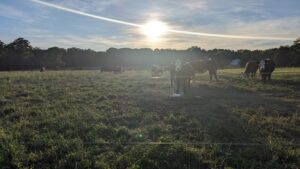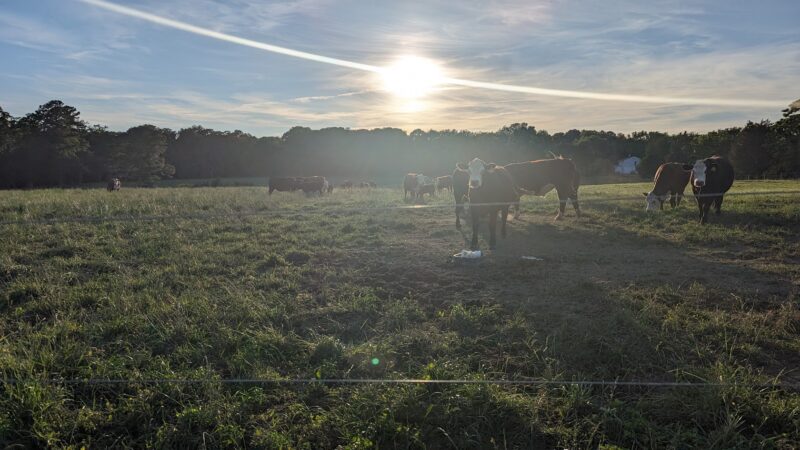
Cows at Rolling Stone Farm in St. Mary’s County. Photo by Rachael Pacella.
Whether it’s waterfront farmland , culturally important land where Harriet Tubman resided, a working farm in Baltimore County, or a stretch of quiet woodlands in Western Maryland, the Maryland Department of Natural Resources (DNR) Rural Legacy Program has been protecting it for a quarter century.
The Maryland Rural Legacy Program protects the viability of agriculture while also conserving natural resources and wildlife habitat within designated Rural Legacy Areas.
The Rural Legacy Program uses perpetual conservation easements to protect properties from development. Landowners are paid to relinquish certain development rights and effect restrictions on their properties ensuring that these working landscapes and habitats remain undeveloped in perpetuity.
Farmers have reported that these payments have helped them expand and enhance their farming operations, while allowing them to protect the rural character of their communities for the future.
The easements are arranged by local sponsors, which include land trusts and county governments. These partners help to protect ecologically-important areas and working landscapes in the 36 designated Rural Legacy Areas that are spread across the state – there is at least one Rural Legacy Area in each of the state’s 23 counties. To date, the Rural Legacy Program has invested $405 million to preserve more than 125,000 acres of land in conservation easements since its inception.
The program recently celebrated its 25-year anniversary. To mark the occasion, DNR visited farms across the state and spoke with landowners about what the program means to them. Read their stories here.
Rolling Stone Farm, St. Mary’s County
Farm name: Rolling Stone Farm
Owners: Roberta and Jon Sola
Location: St. Mary’s County, Mattapany Rural Legacy Area
Easement acreage: 80.97 acres
Year: 2022
Rural Legacy Sponsor: Southern Maryland Resource Conservation and Development Board
About the farm and farmers:
Roberta and Jon Sola took over a family-owned property and are now raising grass-fed cattle, while constantly striving to improve the soil on the land.
Roberta Sola’s great-grandfather moved his operation to the Rolling Stone Farm property in 1942. The family farmed until the 1980s, and then, for 40 years, the property was rented and cultivated by tenant farmers. Roberta’s brother, Robert “Moe” Stone, spent his time weeding, cutting grass, and manicuring the property, caring deeply to keep it as a farm.
When Robert Stone passed in 2018, Roberta inherited the farm. She and her husband, Jon, pursued land preservation to honor Robert’s wish that the property remain a farm in perpetuity.
“He was seeing other local farms turn into developments,” Roberta Sola said.
Now, Roberta and Jon are living out a dream – working full time and farming part-time while enhancing and protecting the land for their children.
The funds from the Rural Legacy conservation easement have allowed them to install regenerative practices on the farm. Since 2020, Jon has raised cattle.
The Solas eventually hope to grow and harvest hay for the cows to eat in the winter. Their cows rotate pastures, chewing grass and fertilizing the ground as they go. Their fields are full of earthworms, which produce some of the most nutrient-dense fertilizer available, Jon Sola said.
The improved soil absorbs more water, lessening runoff, so that the two stormwater ponds on the property are often dry.
The easement permanently protects forest on the property, as well as over 2,000 linear feet of riparian buffer along streams flowing into St. Mary’s River.
The Solas plan on adding chicken trucks to their operation. The truck, an enclosure on wheels with no bottom, will allow the Solas to move their chickens to a recently-grazed cattle field. The chickens scratch up the cow feces, spreading it around the field, and also eat fly larvae. The soil will continue improving, and there will be fewer flies pestering the cows.
The Solas have full-time work outside the farm, so they don’t have to always put profit first, but they may want to step-up the operation in the future, or their children may. They have purchased a commercially-zoned property near the farm, just in case they want to add a storefront to their farming operations one day.
Classes from St. Mary’s College have visited the farm for an eco-tour, and neighbors say they love seeing the cows.
“So there is a community impact,” Roberta Sola said.
The property was conserved through Southern Maryland Resource Conservation and Development Board, Inc. The group has worked with the Rural Legacy Program to conserve over 3,300 acres of land.
“We are delighted to see the Rolling Stone Farm evolve into a successful regenerative farm that is improving the local environment and engaging positively with the community,” Land Conservation Program Director Jessalyn Cockrell said. “Our mission is to help local families conserve their lands for generations to come, and we are excited to see what the Sola’s have planned for their farm in the future.”

Cows at Rolling Stone Farm in St. Mary’s County. Photo by Rachael Pacella.


